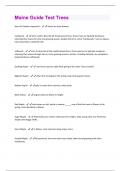Maine Guide Test Trees
deer tick (Ixodes scapularis) - Vector for lyme disease
hardwood - term used to describe all broad-leaved trees. these trees are typically deciduous,
retaining their leaves for only one growing season. despite the term, some "hardwoods," such as aspens,
have wood that is relatively soft.
softwood - term to describe all the needle-leaved trees. these species are typically evergreen,
retaining their leaves through two or more growing seasons. larches, including tamarak, are exceptions,
being deciduous softwoods.
Quaking Aspen - used to be used as cattle feed, giving it the name "biscuit wood"
Bigtooth Aspen - when first emerging in the spring, have silvery-green leaves.
Balsam Poplar - gets its name from resinous, sticky buds.
Black willow - largest native to Maine in height,
Red Maple - also known as soft, white or swamp _____, one of the first trees to flower in the
spring, most abundant in Maine.
Sugar Maple - historically, was used to make parts for sleighs, sleds, pungs (low, one horse box
sleighs) and buggy shafts.
Silver Maple - In Maine, most common along major rivers.
Striped Maple - Moosewood, short tree that loves shade, often found growing with other
hardwoods.
, Mountain Maple - Grows as a tree, seldom over 30 feet in height.
Norway Maple - Native to Europe, casts great shade and was used to be a shade and street tree,
but now is considered a serious threat to native flora.
Boxelder, Ash-leaf maple - Short lived, fast growing, brittle tree that is prone to wind and ice
damage, can be invasive.
Paper, white or canoe birch - Used to make toothpicks and golf tees, historically one of the most
valuable trees in Maine.
Gray Birch - Short lived and not particularly valuable tree, used primarily for pulp and firewood,
small tree that only reaches 20-30 feet in height.
Yellow Birch - The largest of its native type, growing up to 3 feet in diameter and 70-85 feet in
height. One of Maine's most valuable timber trees and makes good firewood.
Sweet, black or cherry birch - Found in the southern third of the state. Wintergreen oil used to be
made from the branches and bark.
mountain paper birch - Often found along the coast and at high elevations, often not considered
distinct from other species that looks and shares a similar name.
eastern hophornbeam or ironwood - The name refers to the fruit that resemble hops.
American hornbeam, blue beech, or musclewood - Occurs west of the Penobscot, small, slow
growing tree that inhabits wet woods or the edges of swamps and streams.
Speckled Alder - Very common in Maine, often growing in wet areas and sometimes in pastures.
Usually occurs as a shrub but sometimes as a small tree, no taller than 20 feet.




